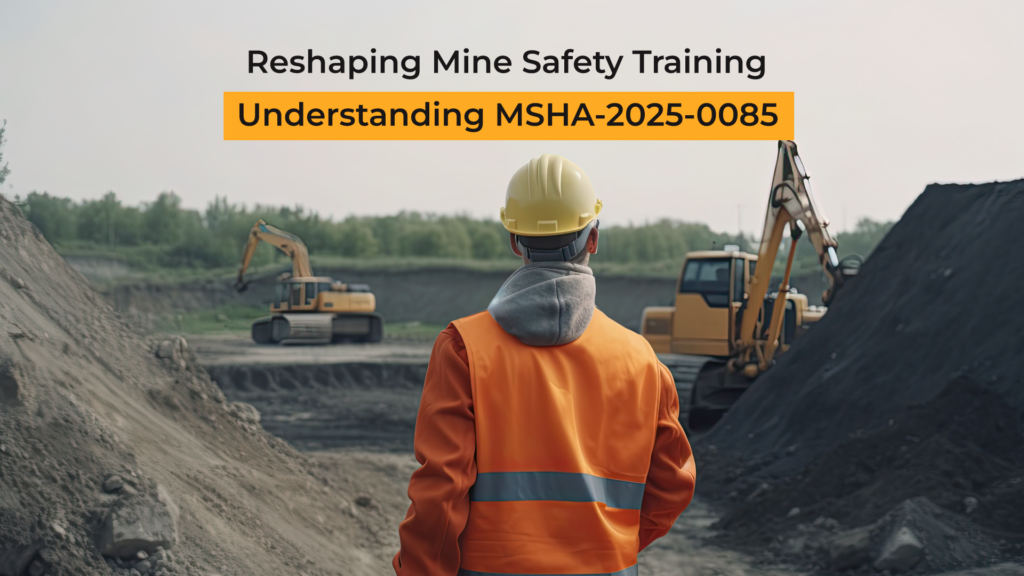The landscape of mine safety is constantly evolving, driven by the unwavering goal of protecting every miner. Recently, the Mine Safety and Health Administration (MSHA) introduced a proposed rule, MSHA-2025-0085, that could significantly reshape how mine safety training programs are managed. This isn’t just a technical adjustment; it’s a potential shift towards greater efficiency and clarity in an area critical to every mining operation.
At Groundhog, we believe in staying at the forefront of these developments because they directly impact the safety and operational effectiveness of the mines we serve. So, let’s break down what this proposed rule means for the industry.
What’s Changing with MSHA-2025-0085?
Currently, MSHA regulations allow District Managers to require specific changes or additions to a mine’s approved training and retraining programs. This means that even after a comprehensive training plan is developed and submitted, it could be subject to further revisions based on individual District Manager discretion.
The proposed rule, MSHA-2025-0085, aims to eliminate these provisions. The core idea is to remove the authority for District Managers to unilaterally mandate revisions to training plans beyond the established regulatory framework. MSHA’s reasoning behind this move points to concerns about statutory authority, the Appointments Clause (regarding significant regulatory power held by unelected officials), and the Administrative Procedure Act, which generally requires public notice and comment for new requirements.
The Implications for Mine Operators
If MSHA-2025-0085 is finalized in its current form, it carries several important implications for mine operators:
1. Reduced Administrative Burden and Cost Savings 📉
One of the most immediate impacts could be a noticeable reduction in administrative workload. Mine operators currently spend time and resources revising training plans at the behest of District Managers. MSHA itself estimates that removing these discretionary revisions could lead to annual cost savings for operators by eliminating the need for further administrative efforts, copying, and mailing of revised plans. This means less paperwork, less back-and-forth, and more time focused on core operations.
2. Enhanced Consistency and Predictability ✅
Imagine a world where your approved training program remains consistent, free from unexpected, individualized changes. This rule aims to provide that. It could bring a new level of predictability and standardization to training requirements across different districts and mines. This consistency is vital for large mining companies with multiple sites, as it allows for more unified and efficient safety program management. It means operators can develop their plans with greater certainty that they meet the set regulations, rather than anticipating subjective alterations.
3. Opportunities for Optimized Training Delivery 🚀
With a clearer, more stable regulatory framework, mines can dedicate more resources and creativity to the delivery of training itself. Instead of focusing on bureaucratic compliance hurdles, the emphasis can shift to:
- Improving training content: Developing more engaging, relevant, and effective materials.
- Adopting modern methodologies: Exploring virtual reality, simulations, and interactive e-learning that truly enhance miner understanding and retention.
- Leveraging technology: Implementing digital tools for training management, record-keeping, and performance tracking that integrate seamlessly with standardized requirements.
At Groundhog, we see this as a significant opportunity for the industry to embrace digital transformation in safety training. Our solutions are designed to help mines manage training records, track certifications, and deliver engaging content in a way that’s efficient and compliant. With potentially fewer moving targets from a regulatory standpoint, the value of robust digital platforms that automate and centralize training management becomes even more pronounced.
What Remains Unchanged: The Commitment to Safety
It’s crucial to understand that this proposed rule does not diminish the absolute necessity of comprehensive, high-quality miner training. The ultimate goal of MSHA remains miner safety and health. Mine operators still have an unwavering responsibility to:
- Provide thorough basic and annual refresher training.
- Identify and mitigate hazards effectively.
- Foster a strong safety culture.
- Ensure every miner is competent and confident in their role.
This proposal is about streamlining the administrative path to achieving those safety objectives, making the regulatory process more efficient without compromising the core commitment to protecting lives.
Changes like MSHA-2025-0085 push our industry to think differently about compliance and efficiency. At Groundhog, we’re ready to partner with mines to navigate these changes, ensuring safety remains paramount while unlocking new levels of operational excellence. Learn more at: https://www.regulations.gov/
